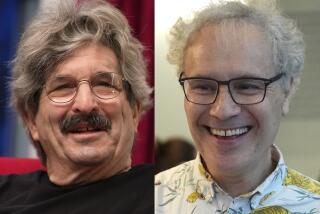2 Share Nobel for Method to Silence Specific Genes
Two researchers, from Stanford University and the University of Massachusetts, won the 2006 Nobel Prize in Physiology or Medicine on Monday for their discovery of a way to shut down individual genes in the body, a technique that holds the possibility of new therapies for macular degeneration, HIV, cancer and other diseases.
Andrew Z. Fire, 47, of the Stanford University School of Medicine and Craig C. Mello, 45, of the University of Massachusetts Medical School will share the $1.37-million prize for their discovery of what the Nobel citation called “a fundamental mechanism for controlling the flow of genetic information.”
The importance of their work was accentuated by the fact that the award, announced Monday, came eight years after their groundbreaking discovery was reported -- an unusual rapidity for a Nobel, which often trails a discovery by decades.
“It’s remarkable how quickly after the discovery was reported that it became a standard tool of research,” said Jeremy M. Berg, director of the National Institute of General Medical Sciences. “The momentum has just been building every year.”
Already, drugs based on gene silencing are in clinical trials for treating macular degeneration, he said, and earlier studies are in progress for treating cancer, HIV infections, influenza and diabetes. The drugs could potentially be used against any disease in which a specific gene is too active.
The researchers received the news in early morning telephone calls. Mello told a news conference that his wife answered first and then hung up, thinking it was a crank call. When the phone rang again, “My wife said, ‘It’s a crank call, don’t get it,’ ” he said.
“I said they are announcing the Nobel Prize. I better pick it up. So I answered the phone, and I think my first words were, ‘You’ve got to be kidding.’ ”
Fire’s call came at 2 a.m., he said, and there was “a certain amount of disbelief: They might have gotten the wrong number, or I might be dreaming.”
He added that he “felt guilty about some of the people who did not receive it,” even though they also made valuable contributions to the field.
He said that he had been watching colleagues who had received similar awards, and that the biggest benefit of the prize was that it provides “an opportunity to have a voice beyond one’s own lab. I look forward to using that voice as it is needed.”
Fire and Mello’s discovery, made while they were working together at the Carnegie Institution of Washington, was totally unexpected.
The genetic blueprint of a cell is contained in DNA, in its nucleus.
To produce the proteins used in cellular processes, the necessary DNA gene is copied onto a strand of genetic material known as messenger RNA, whose job is to carry the information from the nucleus into the main body of the cell. There, it is used as a template to make a specific protein.
Messenger RNA normally exists as a single strand, unlike the usual double-stranded helix of DNA.
Other researchers had observed that injecting extra messenger RNA into cells either did nothing or, paradoxically, actually inhibited protein production.
Researchers trying to enhance the red color of petunias, for example, inserted the messenger RNA for the red pigment. To their astonishment, petals came out white.
Fire and Mello explained how this occurred. They found that the protein-making ability was silenced when researchers inadvertently added a double-stranded form of RNA that was present as a contaminant when the RNA was synthesized in the laboratory.
Working with the humble nematode Caenorhabditis elegans, Fire and Mello showed that when double-stranded RNA bearing the gene for a specific protein was injected into a cell, it sparked a kind of housekeeping, in which the messenger RNA for the same gene was chopped up and destroyed.
They published their findings in the scientific journal Nature in 1998.
Researchers quickly found that this mechanism, called RNA interference or, more commonly, RNAi, is universal, occurring naturally in plants and animals as a way for the cell to control the expression of genes, shutting them off when they are no longer needed.
Researchers speculate that the process originally evolved as a way to fend off viruses, which invade cells with foreign RNA.
The discovery “opened up a whole new universe of research” by giving scientists the ability to shut off genes one by one and thereby determine what each one does, Berg said.
If a disease such as Alzheimer’s, for example, was thought to be produced by a defect in a particular gene, researchers could block the production of that gene in healthy animals and see if Alzheimer’s symptoms developed.
If they did not know what a gene does, they could block its activity and see what goes wrong.
And if a disease, such as macular degeneration or cancer, was caused by the overactivity of a gene, they could block its output and potentially cure the disease.
Thomas R. Cech, president of the Howard Hughes Medical Institute, which funds Mello’s work, called the discovery “a revolution in biomedicine.”
Fire, who was born at the Stanford Hospital, studied mathematics at UC Berkeley “before I realized that I wanted to do something slightly different,” he said. After consulting some Berkeley professors, he enrolled in a doctoral program in biology at MIT.
A year after his graduation, he was appointed to a junior staff position at Carnegie that normally held no prospect of tenure. His research progressed so rapidly in the first three years, however, that he became a full staff member.
He moved to Stanford last November to be near his family.
Mello was drawn into science by his father, who was a paleontologist at the Smithsonian Institution in Washington. “I would go to the Smithsonian and see my dad’s office back behind the dinosaur bones, get to go in there and see the dinosaurs spread out over the table,” he said at the news conference.
“I wanted to be a scientist mainly because I just found the whole human condition and the fact that we are here, and where we came from, fascinating,” he said.
A graduate of Brown and Harvard universities, Mello has been at the University of Massachusetts since 1995.
The medicine Nobel is the first to be awarded this year, and will be followed by those for physics, chemistry, literature, economics and peace. The awards are formally presented at a banquet in Stockholm on Dec. 10 -- with the exception of the peace prize, which is presented in Oslo.
*
*
(BEGIN TEXT OF INFOBOX)
Nobel winners
Craig C. Mello
Age: 45
Position: Professor of molecular medicine, University of Massachusetts Medical School
Previous job: Research fellow, Fred Hutchinson Cancer Research Center, Seattle
Education: Bachelor of science, 1982, Brown University; doctorate in biology, 1990, Harvard
Quote: “Even as a kid, I was captivated by the concept of deep time, the history of the Earth and the origins of human life.”
Andrew Z. Fire
Age: 47
Position: Professor of pathology and genetics at Stanford University
Previous jobs: Adjunct professor of biology at Johns Hopkins University; researcher at the Carnegie Institution of Washington
Education: Bachelor of arts degree in mathematics, 1978, UC Berkeley; doctorate in biology, 1982, MIT
Quote: “My goals are still fairly simple goals, of research, science and teaching and family, and I don’t expect that to change.”
Source: Times research
More to Read
Sign up for Essential California
The most important California stories and recommendations in your inbox every morning.
You may occasionally receive promotional content from the Los Angeles Times.










